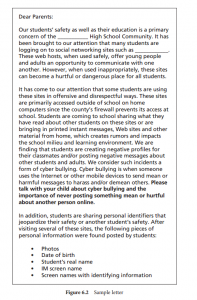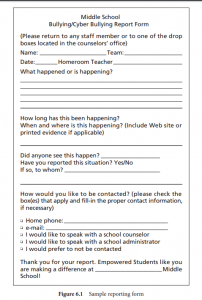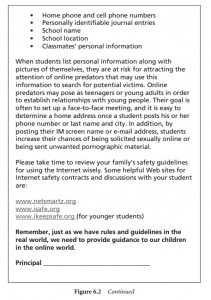Cyber-Bullying
This semester we took two class periods to discuss our online identities and cyber-bullying. During those classes, we looked at different hypothetical situations and how we, as future educators, would handle them. I found this topic to be particularly interesting, and decided to look deeper into the subject as a whole due to how widely effected students in the united states are by cyber-bullying.
What is cyber-bullying?
According to the Cyber-Bullying Research Center, cyber-bullying is defined as “willful and repeated harm inflicted through the use of computers, cell phones, and other electronic devices.” In other-words, it is the intentional harming of an individual through texting/cell phones or social media. The repetition is also an important distinction in order to be classified as bullying.
Who is effected by cyber-bullying and why does it matter?
A survey conducted by the Cyber-Bullying Research Center found that roughly 28% of students had been cyber-bullied, though other stats have indicated a higher number of students experience cyber-bullying. In a 2006 study, 11% of the students surveyed admitted that they had cyber bullied others at least once (and 2% admitting to doing so at least 2–3 times a month. (Kowalski and Limber, 2006) Nearly half of the students who said they had been cyber-bullied said that was targeting from other classmates.
A study performed by A. Weibel and J. Fern also suggest that gender is a factor in the interpretation and experience of cyber-bullying. “For the statement, ‘I consider cyber-bullying to be, using discriminatory language in a joking manner via interactive technologies,’ females agreed more often than males. However, the literature stated if a behavior is interpreted as a joke, then the interaction is not considered cyber-bullying (Nocentini et al., 2010).” An article on Scholastic.com by Caralee Adams states, “While research shows that cyberbullying makes both boys and girls feel angry, sad, and embarrassed, girls are more likely to react with frustration — “Why doesn’t anyone like me?” — while boys are more often scared, perhaps of back alley retribution.” (Adams, 2017)
Do to its repetitive nature, the bullying can be “very emotionally or psychologically damaging,” as well as physically stressing (Cyber-Bullying Research Center, 2014). It can severely impact students’ self-esteem and interfere with their daily lives and academic careers. “Cyber-bullying has the potential to cause public humiliation on a large scale and can have detrimental effects on victims such as suicidal thoughts.” (Weibel and Fern, 2012) The Fund for Civility, Respect and Understanding also cites increased feelings of sadness and loneliness, changes in sleep and eating patterns, loss of interest in activities and increased health complaints as effects of cyber-bullying. The FCRU also says that “bullying can lead to thoughts about suicide, sometimes persisting into adulthood. In one study, adults who were bullied as youth were three times more likely to have suicidal thoughts or inclinations.” (FundforCivility.org, 2017)
What can schools and educators do?
“The stuff [the cyber bullies] said really affected [her]. I don’t know how I could ever say something like that. It was just kind of ridiculous. It made [her] be mean to people for awhile. [She] just didn’t want to do anything with anyone; [she] didn’t want to deal with it. It affected [her] mood, [her] relationships. It affected [her] academically. [She] stopped coming to school for a few days.” – high school female (Kowalski and Limber, 2008)
Due to how widespread this problem really is, as educators, it can be a difficult task to tackle head on. First and foremost, educators need to be aware of how to identify cyber-bullying, or rather, how to recognize it. Where a harmless joke crosses the line into bullying is a blurry and often subjective stance which can make the identification of cyber-bullying even more difficult.
One way a school can address cyber-bullying is through policy implementation. Like the ISTE standards we discussed in class, schools can have a thorough list of standards in their policies that address cyber-bullying, as well as consistent consequences for students who engage in that behavior. The ISTE standard 2B says, “Students engage in positive, safe, legal and ethical behavior when using technology, including social interactions online or when using networked devices.” With clear and concise expectations available for students, there will be no misunderstanding should a problem occur that the school needs to handle.
As a school district, it is important to have supports in place and to have regular discussions with students about the matter, especially about why it is so harmful. These discussions can also include the importance of general internet safety. Having a training system in place for staff on how to deal with cyber-bullies and how to interact with cyber-bully victims can also be very beneficial “to establish a climate that discourages bullying.” Not every staff member needs to be an expert, but all should be aware of it and should have minimal knowledge on the usage of different technologies and social medias that could be used to cyber-bully. This can be beneficial when discussing proper usage.
Sharing resources and information with parents and encouraging reporting of occurrences are also beneficial ways to discourage cyber-bullying.
Sample Reporting Forms:
Future Application
In my future career as an educator, I can take the advice of resources I have introduced by staying informed and up-to-date on the technology students are currently using. By staying up-to-date, I can more effectively demonstrate or explain to students in my class the proper usage and how to ethically navigate online spaces. Using consistent discipline practices for bullying and cyber-bullying is also necessary in order to maintain a safe classroom for all of my students. Also, encouraging students to report their experiences and creating an environment in which they feel comfortable enough to do so is imperative.
Sources
(Course Content Materials)
Corwin. (2005). Resource A: Cyberbullying Scenarios for Discussion. Retrieved from http://cyberbullying.org/cyberbullying-scenarios-2014.pdf
ISTE Standards FORSTUDENTS. (n.d.). Retrieved May, 2017, from https://www.iste.org/standards/standards/for-students
Cyberbullying Effects. (2017). Retrieved May, 2017, from http://fundforcivility.org/cyberbullying-effects/
Cyberbullying: What Teachers and Schools Can Do. (2017). Retrieved May, 2017, from https://www.scholastic.com/teachers/articles/teaching-content/cyberbullying-what-teachers-and-schools-can-do/
Add comment May 10th, 2017



